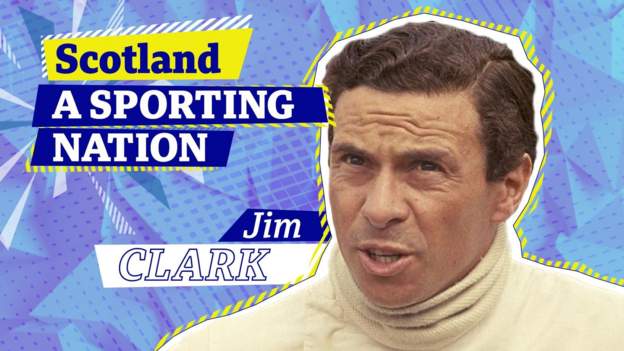Throughout July, BBC Scotland’s Sporting Nation series will reflect on some of the greatest feats and personalities from Scottish sporting history. First up is Jim Clark, a two-time Formula 1 world champion and widely considered to be one of the greatest racing drivers of all time.

Jim Clark’s towering presence in the pantheon of iconic racing drivers was perhaps best encapsulated by another Formula 1 great, the late Ayrton Senna.
The legendary Brazilian commissioned Mexican artist Hugo Escobedo to capture his fantasy grand prix line-up in an oil painting. Juan Fangio, Stirling Moss, Jackie Stewart, Emerson Fittipaldi, Niki Lauda, and of course, Senna himself – the greatest drivers in history.
He gave Escobedo two instructions: first, he must exclude French multiple world champion Alain Prost, his bitter rival; and secondly, pole position among this galaxy of superstars must be filled by Clark. “After all, he was the best of the best,” Senna said.
Clark’s two Formula 1 world championships does not put him in the top 10 in terms of titles but, to many, the Scot is the most naturally gifted driver in the history of motorsport.
Those who raced alongside him, those who worked closely with him, those who observed him at close quarters in any capacity, all agree he had a unique understanding of how to maximise the machine at his disposal. Where mere mortals would push the car to its limits to try and gain that little bit extra, Clark’s approach was different. More serene, more effective.
“He was so smooth, he was so clean, he drove with such finesse. He never bullied a racing car, he sort of caressed it into doing the things he wanted it to do,” is how Jackie Stewart, a fellow Scot who claimed three F1 world titles of his own in the late 1960s and early 1970s, described Clark’s sorcery.
His introduction to top level competitive racing came at the 24 Hours of Le Mans endurance race in 1959. His instincts and feel for his cars made Clark not only a world-class driver, but a versatile one. Sports cars, rally cars, touring cars, Formula 1 cars – he mastered them all.
As well as his F1 world titles in 1963 and 1965 – he would have won in 1964 were it not for an engine oil leak in the final grand prix of the season – Clark won the Indianapolis 500 in the United States.
He is the only driver to capture the F1 and Indy 500 crowns in the same year, also winning the Tasman Series and Formula 2’s Trophees de France in an extraordinary run of success in 1965.
Growing up on farms in Fife and the Borders, and with a naturally shy disposition, the glitz and glamour of life of a racing driver did not always sit easily with Clark. However, as the years passed, his confidence away from the track grew, and his performances on it were without peer.
But in 1968, the unfolding success story of motor racing’s biggest star came to an abrupt and tragic end.
During a gap in the Formula 1 season, Clark was competing in a Formula 2 grand prix in West Germany. On the fifth lap, his Lotus 48 veered off the Hockenheim track and crashed into the trees. He was fatally wounded and died before reaching the hospital. He was 32.
The cause of the crash was never fully determined, with investigators concluding a deflated rear tyre was the most likely explanation. The possibility of driver error was dismissed by Clark’s peers, who refused to believe the brilliant Scot was capable of such a mistake.

Just as his thrilling drives had captured the imagination of racing fans the world over, so Clark’s death shook the sport to its core.
“Jimmy’s death is probably the most tragic thing in the history of motor racing,” said Stewart. “Jimmy was not only a famous driver, he was an international personality, loved by all his fiercest rivals.”
Another colleague, Chris Amon, said of Clark’s death: “If it could happen to him, what chance do the rest of us have? I think we all felt that. It seemed like we’d lost our leader.”
More than half a century since his zenith, Clark is still revered as one of the greats, and his career accomplishments would surely have been burnished with more titles had he not been taken so young.
His records have stood the test of time. From 72 Formula 1 grands prix, he registered 25 wins and 33 pole positions. His winning ratio of 70% in his championship-winning 1963 season has never been matched.
It’s little wonder Clark loomed so large in the life of the young Senna. In 1991, the reigning Formula 1 world champion embarked on a pilgrimage to Scotland, visiting the Jim Clark Museum in Duns in the Scottish Borders, and addressing a crowd of pupils at Clark’s old boarding school, Loretto, in Musselburgh. “Jim Clark was my boyhood hero,” Senna told them.
Just three years later, Senna’s life was cut short in hauntingly similar circumstances to his idol when the Brazilian crashed while leading the 1994 San Marino Grand Prix and died at the age of 34.
Cruelly snatched away in their prime, the legend of both men endures, their exploits and legacies carved in stone. Any debate around the greatest racing driver in history is sure to include the names Clark and Senna. After all, they were the best of the best.
